Development Characteristics and Causes of a Fatal Landslide Occurred in Shuicheng, Guizhou Province, China
Abstract
:1. Introduction
2. Geological Setting
3. Materials and Methods
4. Results
4.1. Characteristics of the Shuicheng Landside
4.1.1. Landform Features
4.1.2. Stratigraphic Structure
- (1)
- Quaternary landslide deposits (Q4del)
- (2)
- The second member (P2β2) of the Emeishan Basalt Formation in upper Permian
4.2. Lessons Learned from Ancient Landslides
5. Discussion
5.1. The Cause of the Shuicheng Landslide
5.2. Suggestions on the Risk Zone of Landslides
6. Conclusions
Author Contributions
Funding
Institutional Review Board Statement
Informed Consent Statement
Data Availability Statement
Conflicts of Interest
References
- Rong, G.Z.; Li, K.W.; Han, L.N.; Alu, S.; Zhang, J.Q.; Zhang, Y.C. Hazard Mapping of the Rainfall–Landslides Disaster Chain Based on GeoDetector and Bayesian Network Models in Shuicheng County, China. Water 2020, 12, 2572. [Google Scholar] [CrossRef]
- Rong, G.Z.; Alu, S.; Li, K.W.; Su, Y.L.; Zhang, J.Q.; Zhang, Y.C.; Li, T.T. Rainfall Induced Landslide Susceptibility Mapping Based on Bayesian Optimized Random Forest and Gradient Boosting Decision Tree Models—A Case Study of Shuicheng County, China. Water 2020, 12, 3066. [Google Scholar] [CrossRef]
- Ma, S.Y.; Xu, C.; Shao, X.Y.; Xu, X.W.; Liu, A.C. A large old landslide in Sichuan Province, China: Surface displacement monitoring and potential instability assessment. Remote Sens. 2021, 13, 2552. [Google Scholar] [CrossRef]
- Cui, Y.L.; Hu, J.H.; Xu, C.; Zheng, J.; Wei, J. A catastrophic natural disaster chain of typhoon-rainstorm-landslide-barrier lake-flooding in Zhejiang Province, China. J. Mt. Sci. 2021, 18, 2108–2119. [Google Scholar] [CrossRef]
- He, X.L.; Xu, C.; Qi, W.W.; Huang, Y.D.; Cheng, J.; Xu, X.W.; Yao, Q.; Lu, Y.K.; Dai, B.Y. Landslides triggered by the 2020 Qiaojia Mw 5.1 Earthquake, Yunnan, China: Distribution, influence factors and tectonic significance. J. Earth Sci. 2021, 32, 1056–1068. [Google Scholar] [CrossRef]
- Li, H.; Shi, W.B.; Zhu, Y.Q.; Peng, X.W. Study on the formation mechanism of “7·23” catastrophic landslide in Shuicheng County, Guizhou Province, China. J. Nat. Disasters 2020, 29, 188–198. (In Chinese) [Google Scholar]
- Lian, X.G.; LI, Z.J.; Yuan, H.V.; Liu, J.B.; Zhang, Y.J.; Liu, X.Y.; Wu, Y.R. Rapid identification of landslide, collapse and crack based on low-altitude remote sensing image of UAV. J. Mt. Sci. 2020, 17, 2915–2928. [Google Scholar] [CrossRef]
- Han, J.L. The Identification of Large-Giant Bedrock Landslides Triggered by Earthquake in the Longmenshan Tectonic Belt. Acta Geol. Sin. 2015, 89, 681–682. [Google Scholar]
- Jiao, Q.S.; Jiang, W.L.; Li, Q. Research on mechanism and process of the Shuicheng landslide in Guizhou based on UAV images. In Proceedings of the International Geoscience and Remote Sensing Symposium, Waikoloa, HI, USA, 26 September–2 October 2020. [Google Scholar]
- Zheng, G.; Xu, Q.; Liu, X.W.; Li, Y.C.; Dong, X.J.; Ju, N.P.; Guo, C. The Jichang landslide on 23 July 2019 in Shuicheng, Guizhou: Characteristics and failure mechanism. J. Eng. Geol. 2020, 28, 541–556. (In Chinese) [Google Scholar]
- Fan, X.Y.; Tang, J.J.; Tian, S.J.; Jiang, Y.J. Rainfall-induced rapid and long-runout catastrophic landslide on 23 July 2019 in Shuicheng, Guizhou, China. Landslides 2020, 17, 2161–2171. [Google Scholar] [CrossRef]
- Li, H.B.; Xu, Y.R.; Zhou, J.W.; Wang, X.K.; Yamagishi, H.; Dou, J. Preliminary analyses of a catastrophic landslide occurred on 23 July 2019, in Guizhou Province, China. Landslides 2020, 17, 719–724. [Google Scholar] [CrossRef]
- Gao, H.Y.; Gao, Y.; He, K.; Li, B.; Zhao, Z.N.; Chen, L.C.; Wang, Y.F. Impact and scraping effects of the high-elevation, long-runout “7.23” landslide in Shuicheng, Guizhou. Carsologica Sin. 2020, 39, 535–546. (In Chinese) [Google Scholar]
- Xia, G.Q.; Liu, C.; Xu, C.; Le, T.C.; Foong, L. Dynamic Analysis of the High-Speed and Long-Runout Landslide Movement Process Based on the Discrete Element Method: A Case Study of the Shuicheng Landslide in Guizhou, China. Adv. Civ. Eng. 2021, 2021, 8854194. [Google Scholar] [CrossRef]
- Chen, X.Z.; Cui, Y.F. The formation of the Wulipo landslide and the resulting debris flow in Dujiangyan City, China. J. Mt. Sci. 2017, 14, 1100–1112. [Google Scholar] [CrossRef]
- Yan, Y.P.; Liu, C.Z.; Chen, H.Q.; Ren, J.; Zhu, C.B. Investigation on catastrophic landslide of 11 January 2013 at Zhaojiagou, Zhenxiong county, Yunnan province. J. Eng. Geol. 2013, 21, 6–15. (In Chinese) [Google Scholar]
- Liu, C.Z. Landslide disaster in Lidong Village, Yaxi Town, Liandu District, Lishui City, Zhejiang Province. Chin. J. Geohazard. Prev. 2015, 26, 5. (In Chinese) [Google Scholar]
- Zhao, W.H.; Wang, R.; Liu, X.W.; Ju, N.P.; Xie, M.L. Field survey of a catastrophic high-speed long-runout landslide in Jichang Town, Shuicheng County, Guizhou, China, on 23 July 2019. Landslides 2020, 17, 1415–1427. [Google Scholar] [CrossRef]
- Ma, S.Y.; Xu, C.; Xu, X.W.; He, X.L.; Qian, H.T.; Jiao, Q.S.; Gao, W.; Yang, H.N.; Cui, Y.L.; Zhang, P.F.; et al. Characteristics and causes of the landslide on 23 July 2019 in Shuicheng, Guizhou Province, China. Landslides 2020, 17, 1441–1452. [Google Scholar] [CrossRef]
- Du, X.L.; Peng, F.; Lan, W.; Zhang, Y.M.; Zhu, Y.L. Analysis of precipitation background of “7.23” Shuicheng landslide. Torrential Rain Disasters 2020, 39, 344–353. (In Chinese) [Google Scholar]
- Zhang, Y.B.; Xing, A.G.; Jin, K.P.; Zhuang, Y.; Bilal, M.; Xu, S.M.; Zhu, Y.Q. Investigation and dynamic analyses of rockslide-induced debris avalanche in Shuicheng, Guizhou, China. Landslides 2020, 17, 2189–2203. [Google Scholar] [CrossRef]
- Caracciolo, D.; Arnone, E.; Conti, F.; Noto, L. Exploiting historical rainfall and landslide data in a spatial database for the derivation of critical rainfall thresholds. Environ. Earth Sci. 2017, 76, 1–16. [Google Scholar] [CrossRef]
- Iverson, R.M. Landslide triggering by rain infiltration. Water Resour. Res. 2020, 36, 1897–1910. [Google Scholar] [CrossRef] [Green Version]
- Li, W.C.; Dai, F.C.; Wei, Y.Q.; Wang, M.L.; Min, H.; Lee, L.M. Implication of subsurface flow on rainfall-induced landslide: A case study. Landslides 2015, 13, 1109–1123. [Google Scholar] [CrossRef]
- Lamens, P.; Askarinejad, A. Pile driving and submarine slope stability: A hybrid engineering approach. Landslides 2021, 18, 1351–1367. [Google Scholar] [CrossRef]
- Zhan, J.N.; Zhou, Z.; Lin, F.; Yang, Q.G.; Luo, Y. Failure mechanism of a slow-moving landslide on 27 September 2020, in Chang Nong Village, Guangxi, China. Landslides 2021, 18, 2575–2592. [Google Scholar] [CrossRef]
- Wang, Y.; Zhao, B.; Li, J. Mechanism of the catastrophic June 2017 landslide at Xinmo Village, Songping River, Sichuan Province, China. Landslides 2017, 15, 333–345. [Google Scholar] [CrossRef]
- Wen, B.; Wang, S.; Wang, E.; Zhang, J. Characteristics of rapid giant landslides in China. Landslides 2004, 1, 247–261. [Google Scholar] [CrossRef]
- Ma, S.; Xu, C.; Shao, X.; Zhang, P.; Liang, X.; Tian, Y. Geometric and kinematic features of a landslide in Mabian Sichuan, China, derived from UAV photography. Landslides 2019, 16, 373–381. [Google Scholar] [CrossRef]
- Yin, Y.; Cheng, Y.; Liang, J.; Wang, W. Heavy-rainfall-induced catastrophic rockslidedebris flow at Sanxicun, Dujiangyan, after the Wenchuan Ms 8.0 earthquake. Landslides 2016, 13, 9–23. [Google Scholar] [CrossRef]
- Abe, S.; Tien, D.; Ngoc, H.D.; Hoshide, T.; Nishitani, T.; Miyagi, T. Topography and landslides in weathered granitic rock areas—Hai Van landslide in central Vietnam. Landslides 2018, 15, 1675–1689. [Google Scholar] [CrossRef]
- Wang, Y.; Jin, J.L.; Yuan, R.M. Analysis on Spatial Distribution and Influencing Factors of Geological Disasters in Southeast Tibet. J. Seismol. Res. 2019, 42, 198–199. [Google Scholar]
- Roy, S.; Baruah, A.; Misra, S.; Mandal, N. Effects of bedrock anisotropy on hillslope failure in the Darjeeling-Sikkim Himalaya: An insight from physical and numerical models. Landslides 2015, 12, 927–941. [Google Scholar] [CrossRef]
- Louise, M.; Martina, B.; Line, R.; Steffen, G.B.; Geoffre, D.C.; Tom, R.L. Structurally controlled rock slope deformation in northern Norway. Landslides 2020, 17, 1745–1776. [Google Scholar]
- Rabby, Y.W.; Li, Y.K. An integrated approach to map landslides in Chittagong Hilly Areas, Bangladesh, using Google Earth and field mapping. Landslides 2019, 16, 633–645. [Google Scholar] [CrossRef]
- Siyamack, S.; Mohsen, E.M.; Soheilnaz, D. Mechanism of landslide damming in Morzarrin Valley and its consequences, Lorestan Province, western Iran. Landslides 2021, 18, 1823–1832. [Google Scholar]
- Xu, C. Preparation of Earthquake-Triggered Landslide Inventory Maps Using Remote Sensing and GIS Technologies: Principles and Case Studies. Geosci. Front. 2015, 6, 825–836. [Google Scholar] [CrossRef] [Green Version]
- Panday, S.; Dong, J.J. Topographical features of rainfall-triggered landslides in Mon State, Myanmar, August 2019: Spatial distribution heterogeneity and uncommon large relative heights. Landslides 2021, 18, 3875–3889. [Google Scholar] [CrossRef]
- Youssef, A.M.; Pourghasemi, H.R.; Pourtaghi, Z.S.; Al-Katheeri, M.M. Landslide susceptibility mapping using random forest, boosted regression tree, classification and regression tree, and general linear models and comparison of their performance at Wadi Tayyah Basin, Asir Region, Saudi Arabia. Landslides 2016, 13, 839–856. [Google Scholar] [CrossRef]
- Xu, C.; Xu, X.W.; Yao, X.; Dai, F.C. Three (Nearly) Complete Invento-ries of Landslides Triggered by the 12 May 2008 Wenchuan Mw7.9 Earthquake of China and Their Spatial Distribution Statistical Analysis. Landslides 2014, 11, 441–461. [Google Scholar] [CrossRef] [Green Version]
- Corominas, J. The angle of reach as a mobility index for small and large landslides: Reply. Can. Geotech. J. 1996, 33, 1029–1031. [Google Scholar] [CrossRef]
- Xu, C.; Xu, X.W.; Tian, Y.Y.; Shen, L.L.; Yan, Q.; Huang, X.Q.; Ma, J.X.; Chen, X.; Ma, S.Y. Two Comparable Earthquakes Produced Greatly Different Coseismic. Landslides: The 2015 Gorkha, Nepal and 2008 Wenchuan, China Events. J. Earth Sci. 2016, 27, 1008–1015. [Google Scholar] [CrossRef] [Green Version]
- Ma, C.; Xie, Z.M.; Li, M. Types and hazard levels of Nanshan landslides at the junction of Yushibulake Village and Qapuhe Awuzi Village, Xinyuan County, Xinjiang. Xinjiang Nonferrous Met. 2021, 44, 26–27. (In Chinese) [Google Scholar]
- Ma, S.; Shao, X.; Xu, C.; He, X.; Zhang, P. MAT.TRIGRS (V1.0): A new open-source tool for predicting spatiotemporal distribution of rainfall-induced landslides. Nat. Hazards Res. 2021. [Google Scholar] [CrossRef]
- Guo, J.; Yi, S.J.; Yin, Y.Z.; Cui, Y.F.; Qin, M.Y.; Li, T.L.; Wang, C.Y. The effect of topography on landslide kinematics: A case study of the Jichang town landslide in Guizhou, China. Landslides 2020, 17, 959–973. [Google Scholar] [CrossRef]
- Li, S.S.; Li, G.P.; Wang, X.F.; Li, C.; Liu, H.Z.; Li, G. Precipitation Characteristics of an Abrupt Heavy Rainfall Event over the Complex Terrain of Southwest China Observed by the FY-4A Satellite and Doppler Weather Radar. Water 2020, 12, 2502. [Google Scholar] [CrossRef]
- Liu, X.L.; Chen, X.; Su, M.; Zhang, S.L.; Lu, D.F. Stability Analysis of a Weathered-Basalt Soil Slope Using the Double Strength Reduction Method. Adv. Civ. Eng. 2021, 2021, 6640698. [Google Scholar] [CrossRef]
- Zhou, J.W.; Li, H.B.; Lu, G.D.; Zhou, Y.; Zhang, J.Y.; Fan, G. Initiation mechanism and quantitative mass movement analysis of the 2019 Shuicheng catastrophic landslide. Q. J. Eng. Geol. Hydrogeol. 2020, 54, 1–12. [Google Scholar] [CrossRef]
- Parker, R.N.; Densmore, A.L.; Rosser, N.J. Mass wasting triggered by the 2008 Wenchuan earthquake is greater than orogenic growth. Nature 2011, 4, 449–452. [Google Scholar] [CrossRef] [Green Version]
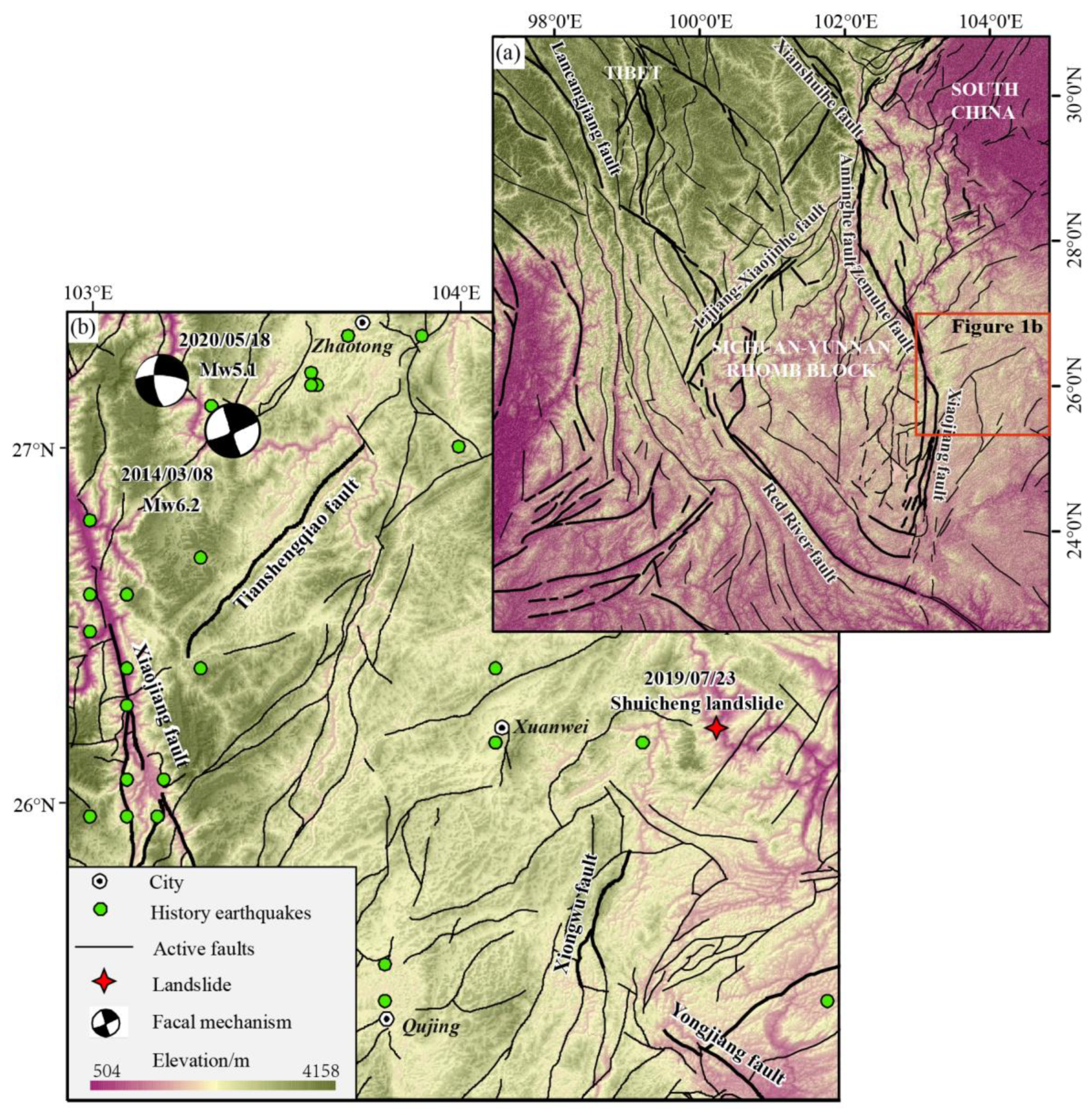
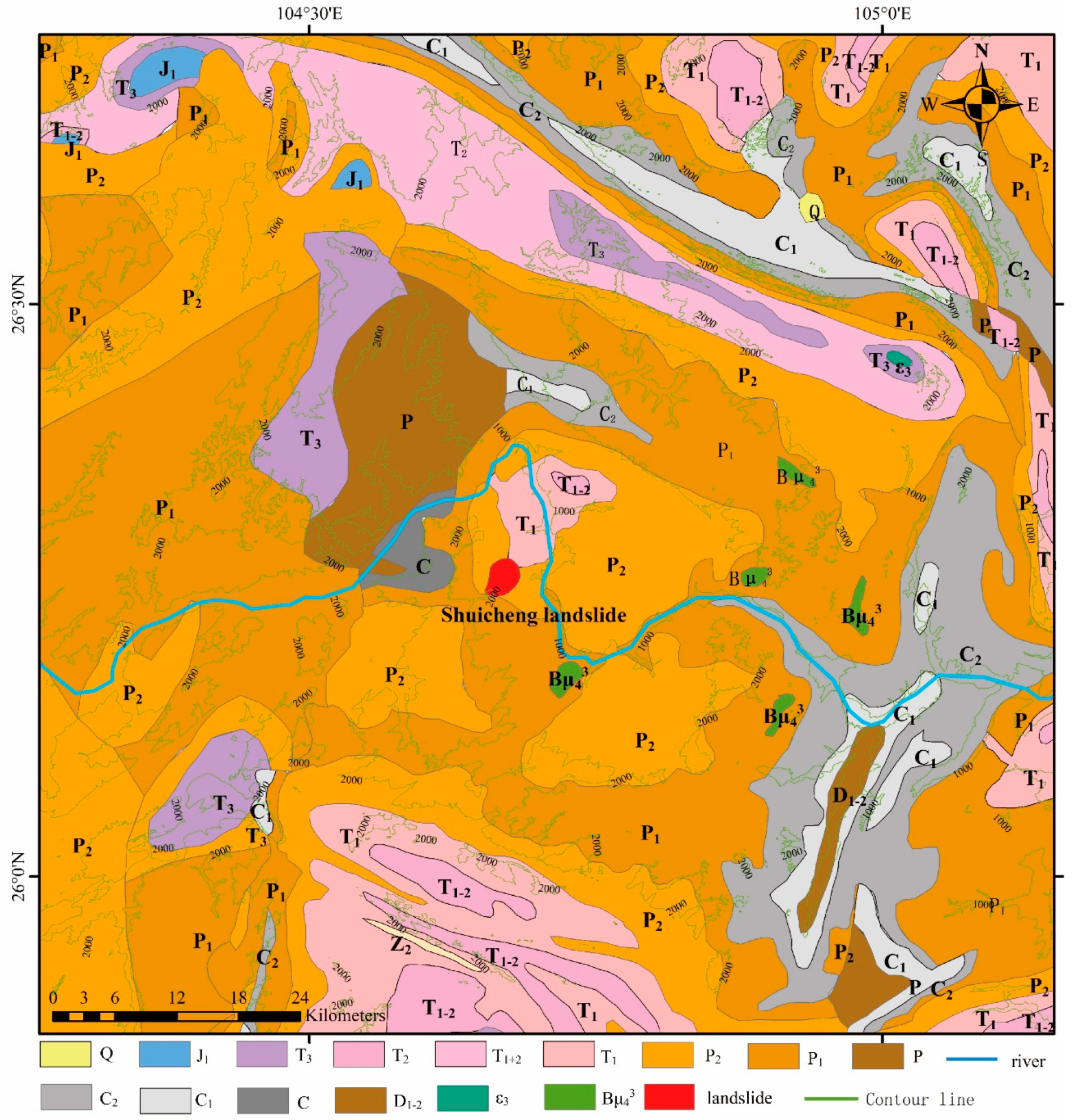

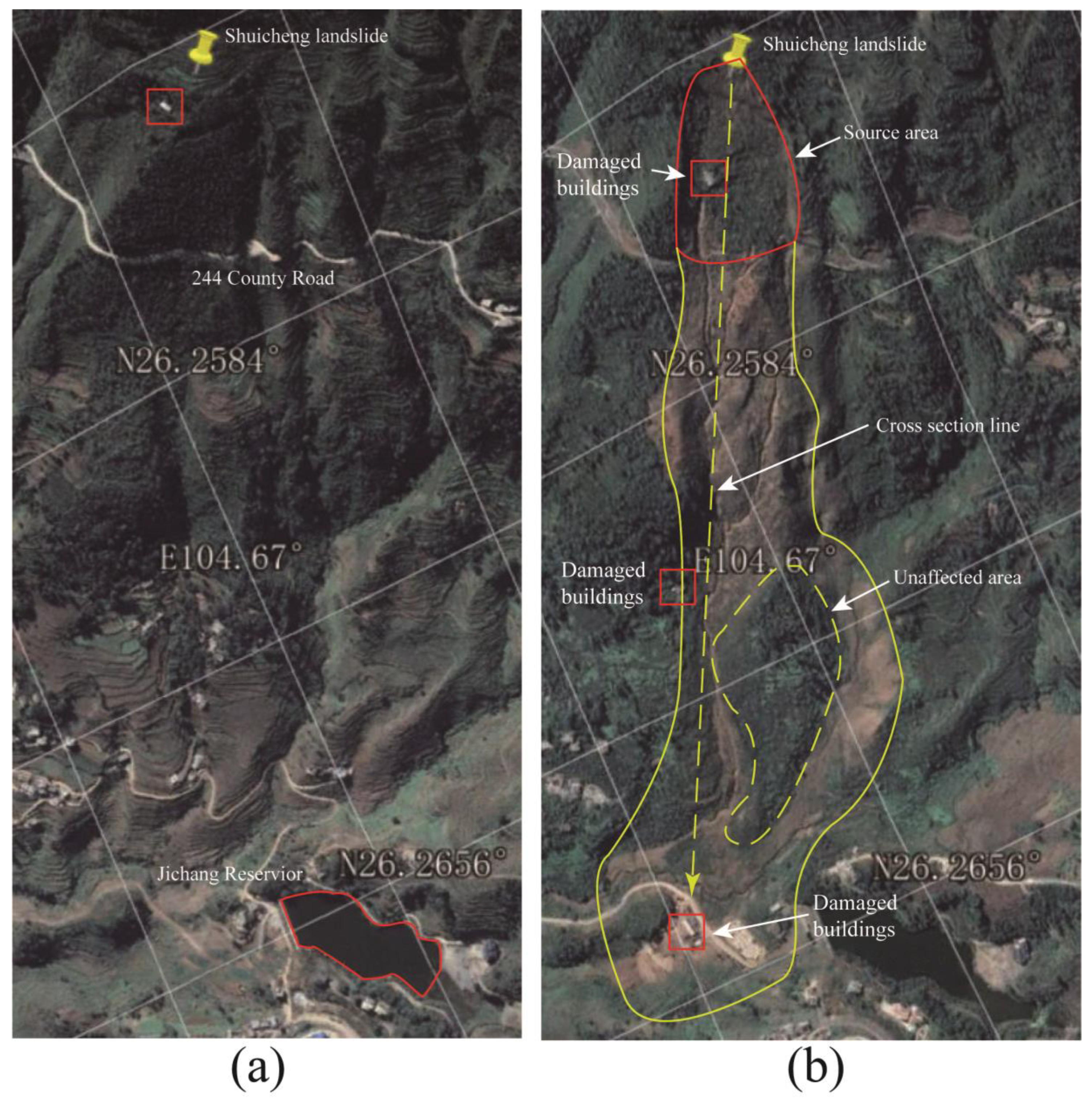
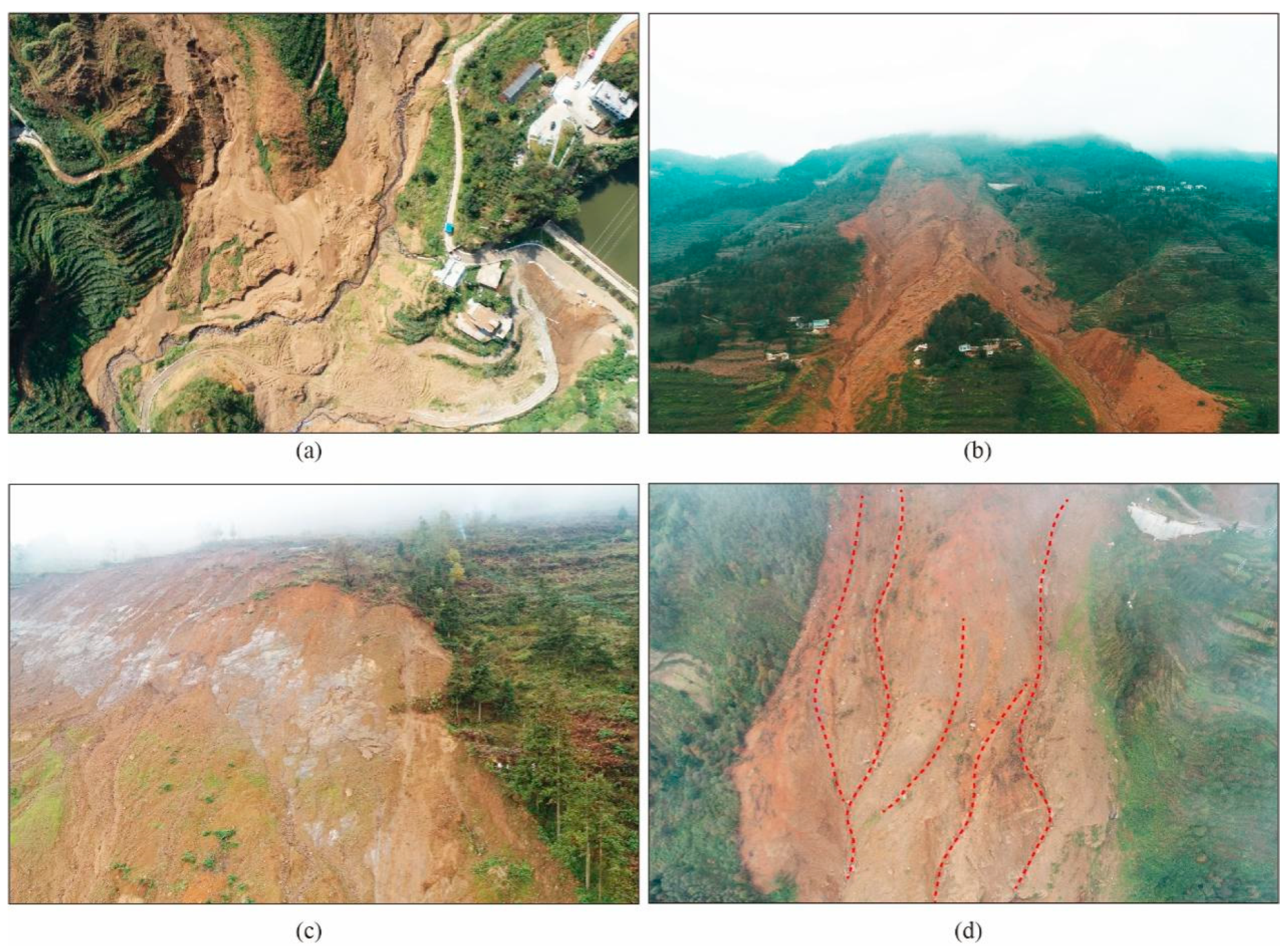
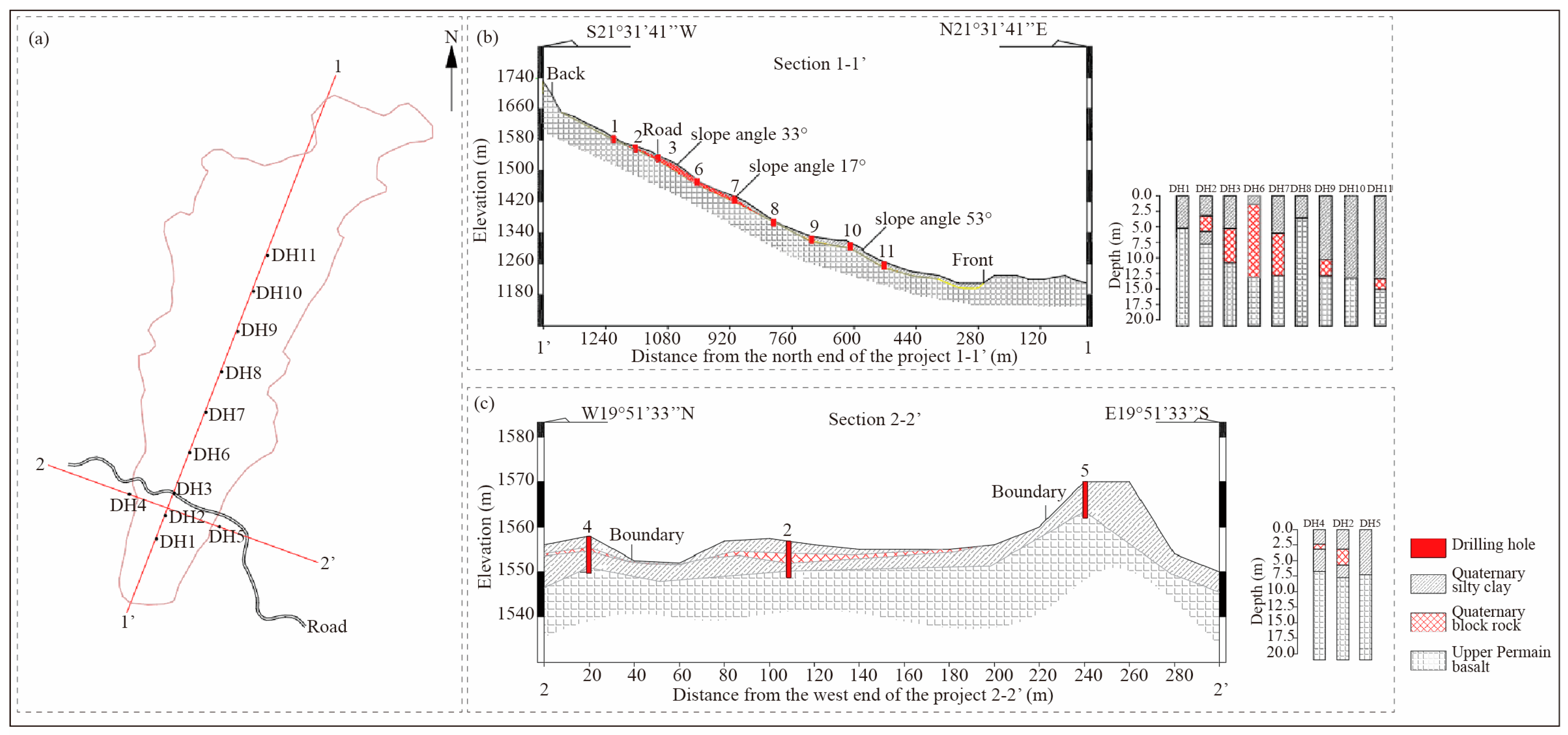
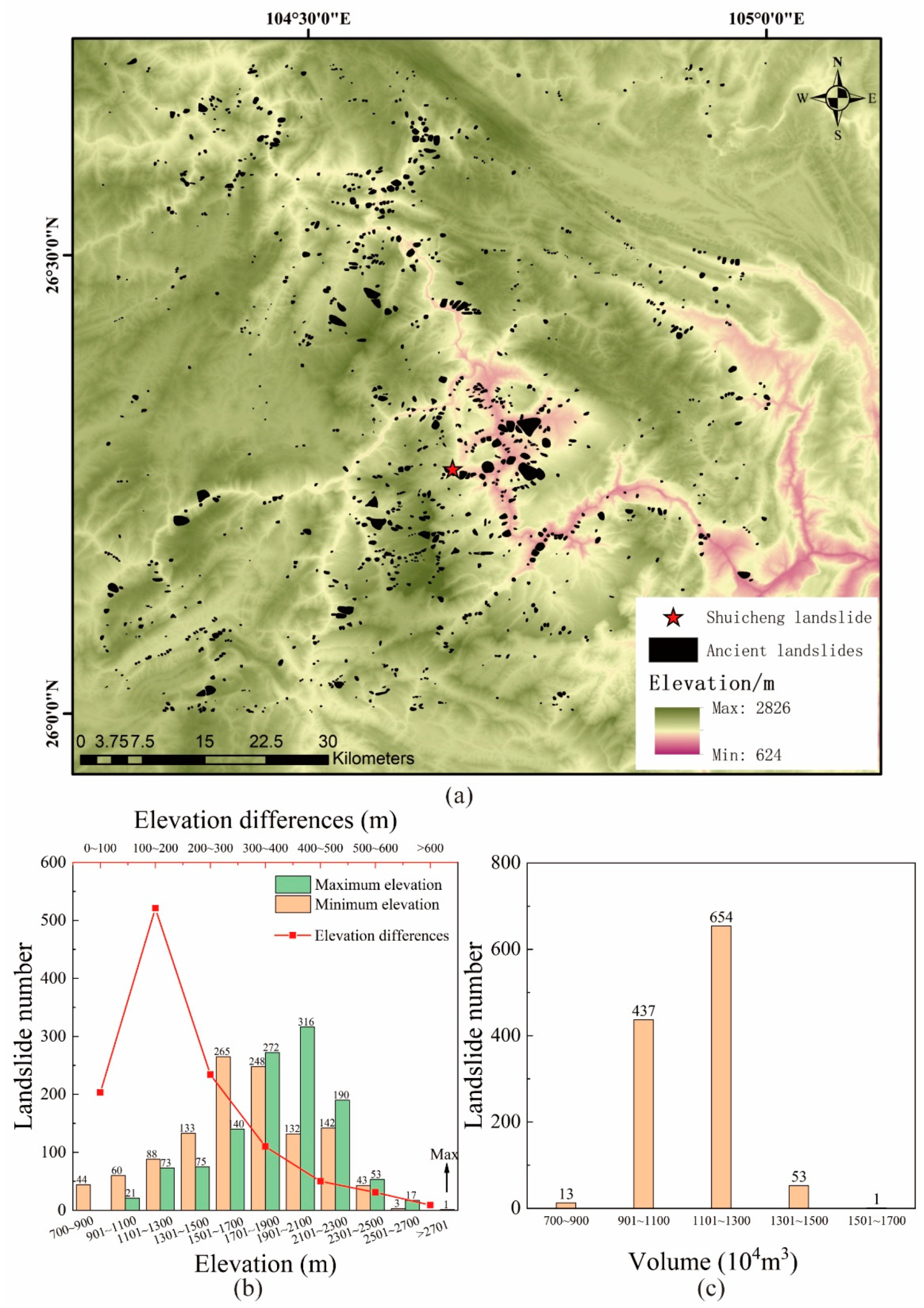
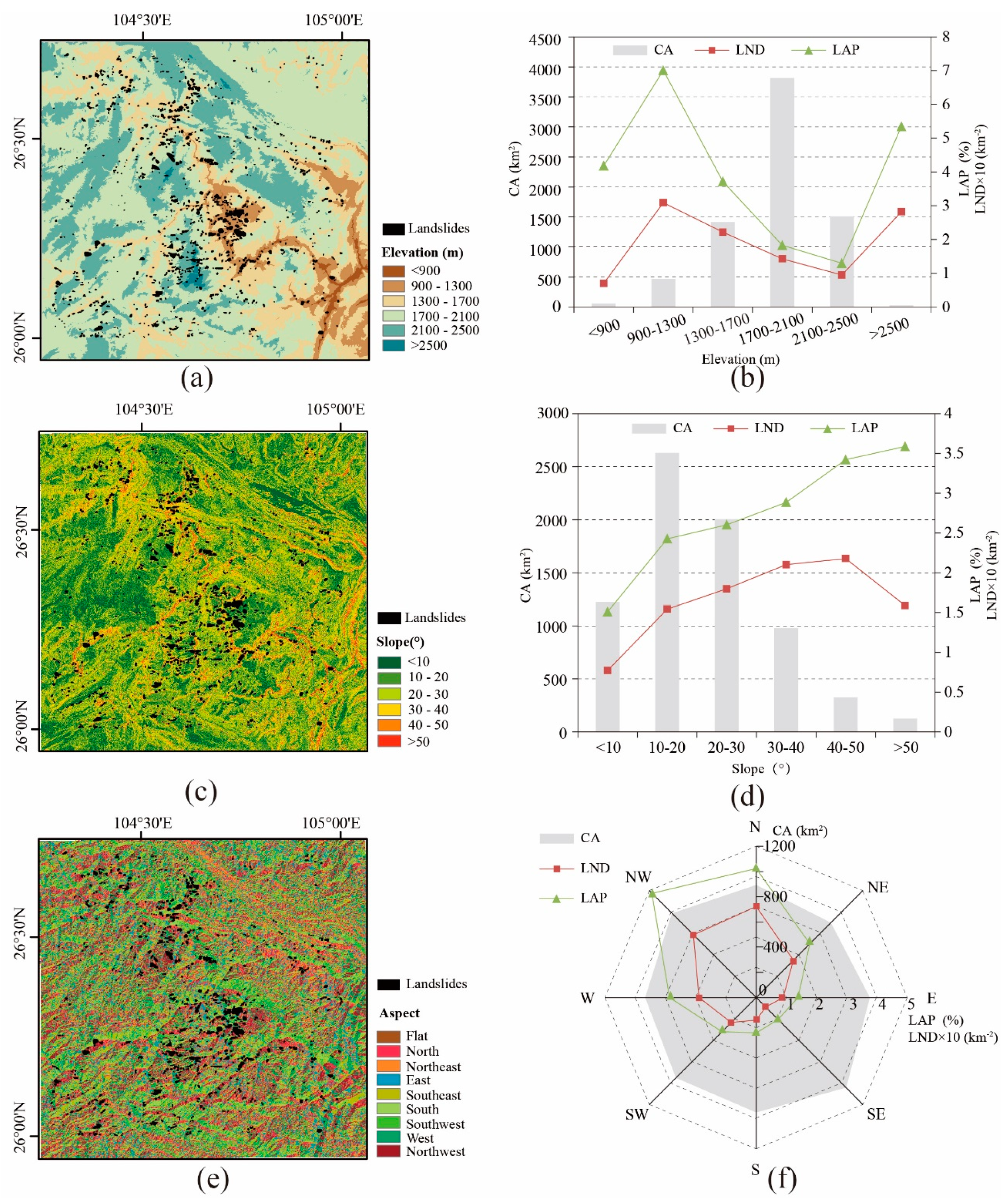
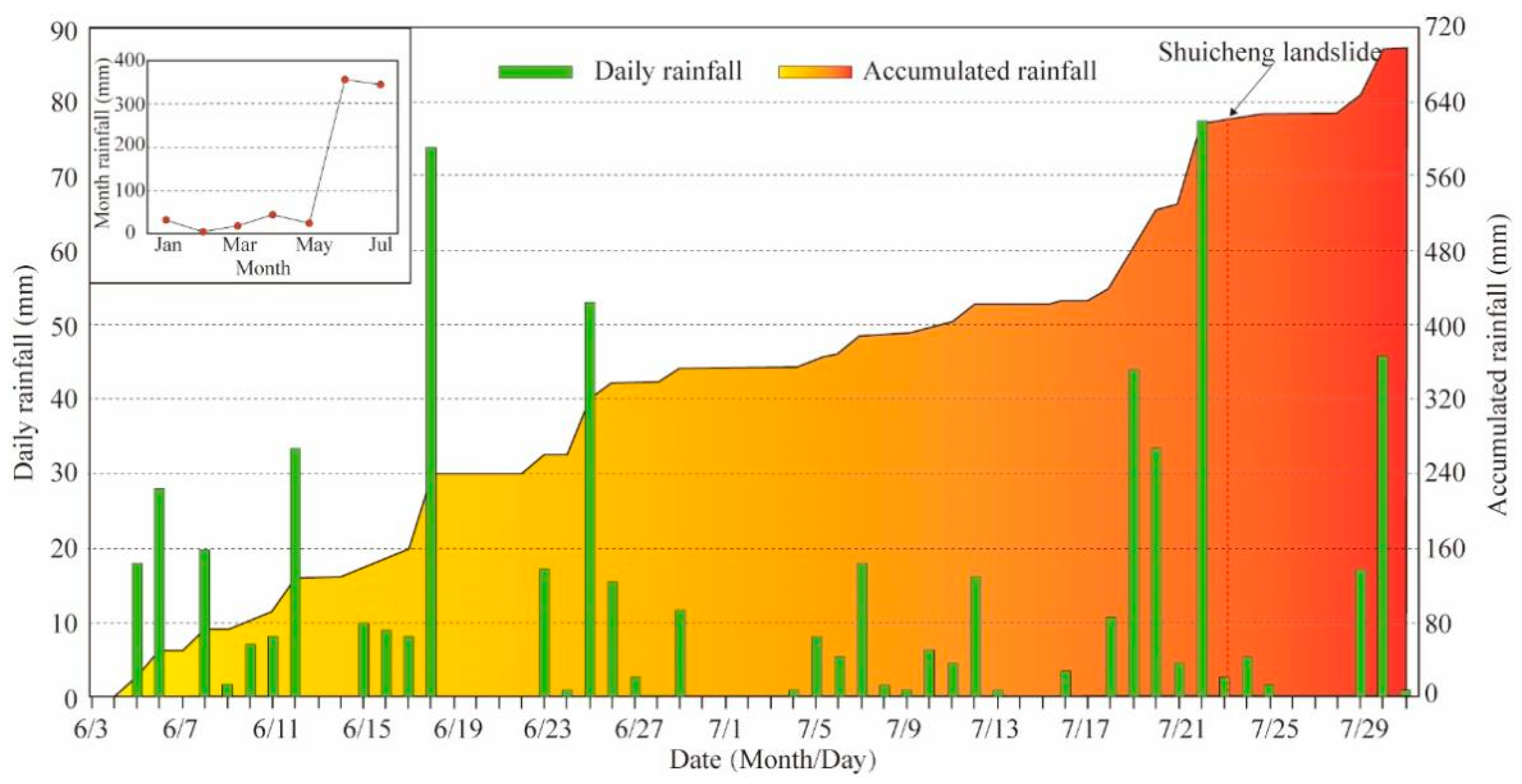
| Data Sources | Source Area (m2) | Slope Height (m) | Actual Sliding Distance (m) | Maximum of Empirical Sliding Distance (m) | Minimum of Empirical Sliding Distance (m) |
|---|---|---|---|---|---|
| Ma et al. (2020) [19] | 45,000 | 500 | 1400 | 1974.219148 | 1190.261406 |
| Gao et al. (2020) [13] | 48,000 | 460 | 1430 | 1830.164032 | 1103.410235 |
| Obtained from Google Earth | 33,200 | 480 | 1300 | 1828.455738 | 1102.3803 |
Publisher’s Note: MDPI stays neutral with regard to jurisdictional claims in published maps and institutional affiliations. |
© 2022 by the authors. Licensee MDPI, Basel, Switzerland. This article is an open access article distributed under the terms and conditions of the Creative Commons Attribution (CC BY) license (https://creativecommons.org/licenses/by/4.0/).
Share and Cite
Chen, Y.; He, X.; Xu, C.; Huang, Y.; Zhang, P.; Luo, Z.; Zhan, T. Development Characteristics and Causes of a Fatal Landslide Occurred in Shuicheng, Guizhou Province, China. ISPRS Int. J. Geo-Inf. 2022, 11, 119. https://doi.org/10.3390/ijgi11020119
Chen Y, He X, Xu C, Huang Y, Zhang P, Luo Z, Zhan T. Development Characteristics and Causes of a Fatal Landslide Occurred in Shuicheng, Guizhou Province, China. ISPRS International Journal of Geo-Information. 2022; 11(2):119. https://doi.org/10.3390/ijgi11020119
Chicago/Turabian StyleChen, Yu, Xiangli He, Chong Xu, Yuandong Huang, Pengfei Zhang, Zhihua Luo, and Tao Zhan. 2022. "Development Characteristics and Causes of a Fatal Landslide Occurred in Shuicheng, Guizhou Province, China" ISPRS International Journal of Geo-Information 11, no. 2: 119. https://doi.org/10.3390/ijgi11020119
APA StyleChen, Y., He, X., Xu, C., Huang, Y., Zhang, P., Luo, Z., & Zhan, T. (2022). Development Characteristics and Causes of a Fatal Landslide Occurred in Shuicheng, Guizhou Province, China. ISPRS International Journal of Geo-Information, 11(2), 119. https://doi.org/10.3390/ijgi11020119







